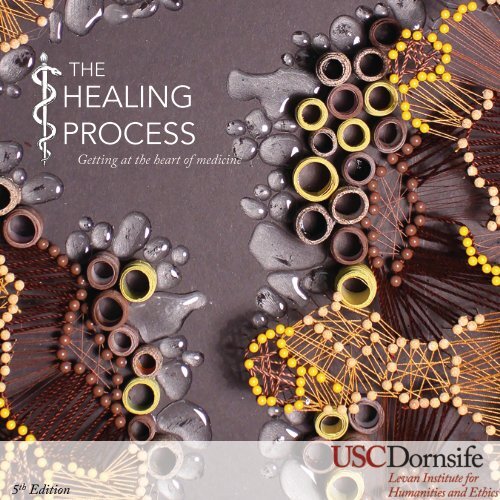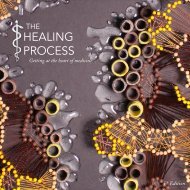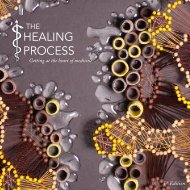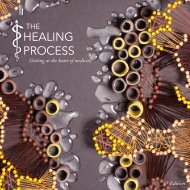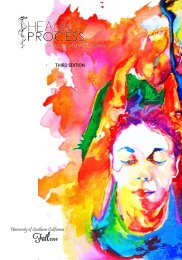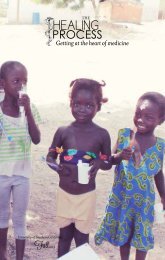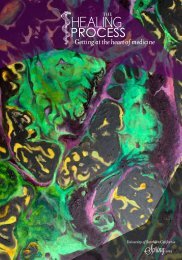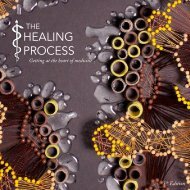final_thp_5thedition
You also want an ePaper? Increase the reach of your titles
YUMPU automatically turns print PDFs into web optimized ePapers that Google loves.
THE<br />
HEALING<br />
PROCESS<br />
Getting at the heart of medicine<br />
5 th Edition
A Letter from the Editors…<br />
Dear Readers,<br />
Thank you for picking up the fifth edition of<br />
The Healing Process! It’s been a long year<br />
and a half since we released our last edition,<br />
but we hope you might see the breadth and<br />
depth of creative energy, emotion, and<br />
intellect that we have the privilege of<br />
presenting to you now.<br />
If this is your first time seeing The Healing<br />
Process, we hope you might be as<br />
captivated as we were when we first<br />
encountered it. Since 2012, this special<br />
magazine has uncovered the intricate link<br />
between medicine and humanity, art and<br />
science. The infinitely talented artists and<br />
writers who contribute to our publication<br />
explore how humans occupy and<br />
understand their space in a world of<br />
constant scientific and medical discovery,<br />
redefining what we might consider science,<br />
disease, art, or healing.<br />
The cover for this edition is a submission<br />
from Alana Barrett. The artist used a<br />
microscope and camera to display the<br />
appearance of food items from a new<br />
perspective. These photographs were then<br />
used as models to create abstract<br />
representations of the food items in a<br />
collection of works entitled “Micro Lab.”<br />
The cover photo is entitled “Yogurt and<br />
Granola,” made from pins, thread,<br />
embroidery floss, quilled paper rolls, spray<br />
paint, and resin. The intricacy of this piece<br />
inspires a sort of wonder: what else do we<br />
not always see? How else might science and<br />
its tools help us transcend the ordinary to<br />
reveal the extraordinary?<br />
We hope you keep this spirit of curiosity as<br />
you flip through these pages, going beyond<br />
ordinary definitions to create a deeper,<br />
more holistic understanding of human life<br />
and its accompanying challenges. We<br />
encourage you to employ the lens of<br />
scientific analysis, an artistic eye, and an<br />
empathetic heart to understand the stories<br />
we’ve chosen to share here.<br />
Finally, we would like to thank the entities<br />
who have supported us in creating this<br />
edition: the USC Levan Institute; USC’s<br />
Academic Culture Assembly; our advisor,<br />
Dr. Atia Sattar; editorial teams past and<br />
present; and, most importantly, the artists<br />
and writers who’ve shared their work with<br />
us. We hope as you read that you might<br />
find for yourself the meaning of art, science,<br />
and their relationship to one another.<br />
Sincerely,<br />
Megha Gupta and Kelsi Yu
Table of Contents<br />
3 Spinal Tap<br />
Alana Barrett<br />
4 Cardium<br />
Desmond Chin<br />
5 Premed Struggles<br />
Bonnie Park<br />
7 The Future of Medicine<br />
Rachel Polcyn<br />
8 Defining the Modern Intellect Megha Gupta<br />
12 Meditation and Prayer<br />
Austin Dalgleish<br />
13 It’s Kind of a Funny Story Mahima Shah Verma<br />
15 If Anyone Asks<br />
Amy Hutto<br />
17 Ardent Son<br />
William Brochinsky<br />
19 Mind Body Health<br />
Jean Wu<br />
23 Year of the Fish<br />
Camilla Teng<br />
25 A Solitary Light<br />
Amy Hutto<br />
27 Hope<br />
Helen Jin<br />
29 Secret of Healing<br />
Lisa Kam<br />
31 Books We Recommend<br />
Cover Art: Yogurt and Granola Alana Barrett
SPINAL TAP<br />
Alana Barrett
. . . . . .<br />
PAGE | 4
FOR&TOO&MANY&NIGHTS&I&WOULD&WATCH&THE&SUN&RISE<br />
STUDYING,&HOPING&THAT&MY&DREAMS&DON’T&DEMISE<br />
STUCK&IN&BETWEEN&MY&IDEALS&AND&REALITY<br />
I&WAS&REEXAMINING&MY&PREMED&MENTALITY<br />
THE&COMPETITION&FOR&MED&SCHOOL&IS&TOO&INSANE<br />
2%&ACCEPTANCE&FOR&THOSE&PEOPLE&WITH&BIG&BRAIN<br />
I&THINK&I’M&TOO&PLAIN&FOR&THE&DOCTORAL&DOMAIN<br />
OR&WILL&I&GET&TO&POP&THE&CHAMPAGNE&ONE&DAY?<br />
WHITE&GOWN,&STETHOSCOPE&AND&BLUE&SCRUBS<br />
TURNING&UP&BOOKS&INSTEAD&OF&AT&THE&CLUBS<br />
I&WONDER&IF&ALL&THESE&EFFORTS&NOW&WILL&LATER&PAY&OFF<br />
IS&IT&REALLY&WORTH&NOT&HAVING&MY&DAY&OFF?<br />
BLOOD,&NEEDLES,&SURGERIES,&LIFE&AND&DEATH<br />
AGAIN&I&WONDER&IF&THIS&IS&THE&WORTHY&PAIN<br />
SOON&I&WILL&HAVE&TO&MAKE&GOOD&DECISIONS<br />
HOPEFULLY&I&CAN&SEE&MYSELF&THROUGH&BRIGHT&VISIONS<br />
PREMED&<br />
I&DON’T&KNOW&WHY,&BUT&I&CAN’T&STOP&THINKING&ABOUT&IT<br />
THE&ART&OF&MEDICINE,&AND&DRAWING&THE&LINE&OF&COMPARISON<br />
OF&LIFE&AND&DEATH&MAKES&ME&FEEL&COMPLETE<br />
IN&THOUGHT&OF&IT,&MY&HEART&JOYFULLY&BEATS<br />
I’LL&PROBABLY&HAVE&TO&SURVIVE&THE&TEST&OF&TIME<br />
AND&MAKE&SURE&MY&SOLID&DREAM&DOESN’T&SUBLIME<br />
STRUGGLES<br />
IF&TODAY’S&A&HILL,&I&HAVE&A&DOZEN&MOUNTAINS&TO&CLIMB<br />
MY&LIFE&IS&LIKE&A&COIN,&TWO&SIDES&OF&A&DIME<br />
BUT&AT&THIS&POINT,&I’M&SURE&MEDICINE&IS&MINE<br />
STAYING&UP&ALL&NIGHT&HEALING&PEOPLE’S&BODIES&AND&MINDS<br />
WELCOMING&YOUNG&AND&OLD&FROM&ALL&RACES&AND&KINDS<br />
TAKING&VITALS&AND&READING&EKG&LINES<br />
THOUGH&YOUNG&AND&RECKLESS,&I’M&LIKE&A&HOSPITAL@ FULL&OF&PATIENCE<br />
HOPEFULLY&SOON&I’LL&REMEMBER&TODAY&AS&OF&ANCIENT<br />
AS&I&REACH&THE&TOP&OF&MY&OWN&PYRAMID,&AND&BECOME&THAT&ONE&PERSON&TO&LEAD<br />
I&SHALL&LOOK&BACK&AND&REMEMBER&I&TOO&WAS&ONCE&A&KID<br />
BY:&BONNIE&PARK<br />
PAGE | 5
FOR&TOO&MANY&NIGHTS&I&WOULD&WATCH&THE&SUN&RISE<br />
STUDYING,&HOPING&THAT&MY&DREAMS&DON’T&DEMISE<br />
STUCK&IN&BETWEEN&MY&IDEALS&AND&REALITY<br />
I&WAS&REEXAMINING&MY&PREMED&MENTALITY<br />
THE&COMPETITION&FOR&MED&SCHOOL&IS&TOO&INSANE<br />
2%&ACCEPTANCE&FOR&THOSE&PEOPLE&WITH&BIG&BRAIN<br />
I&THINK&I’M&TOO&PLAIN&FOR&THE&DOCTORAL&DOMAIN<br />
OR&WILL&I&GET&TO&POP&THE&CHAMPAGNE&ONE&DAY?<br />
WHITE&GOWN,&STETHOSCOPE&AND&BLUE&SCRUBS<br />
TURNING&UP&BOOKS&INSTEAD&OF&AT&THE&CLUBS<br />
I&WONDER&IF&ALL&THESE&EFFORTS&NOW&WILL&LATER&PAY&OFF<br />
IS&IT&REALLY&WORTH&NOT&HAVING&MY&DAY&OFF?<br />
BLOOD,&NEEDLES,&SURGERIES,&LIFE&AND&DEATH<br />
AGAIN&I&WONDER&IF&THIS&IS&THE&WORTHY&PAIN<br />
SOON&I&WILL&HAVE&TO&MAKE&GOOD&DECISIONS<br />
HOPEFULLY&I&CAN&SEE&MYSELF&THROUGH&BRIGHT&VISIONS<br />
I&DON’T&KNOW&WHY,&BUT&I&CAN’T&STOP&THINKING&ABOUT&IT<br />
THE&ART&OF&MEDICINE,&AND&DRAWING&THE&LINE&OF&COMPARISON<br />
OF&LIFE&AND&DEATH&MAKES&ME&FEEL&COMPLETE<br />
IN&THOUGHT&OF&IT,&MY&HEART&JOYFULLY&BEATS<br />
I’LL&PROBABLY&HAVE&TO&SURVIVE&THE&TEST&OF&TIME<br />
AND&MAKE&SURE&MY&SOLID&DREAM&DOESN’T&SUBLIME<br />
IF&TODAY’S&A&HILL,&I&HAVE&A&DOZEN&MOUNTAINS&TO&CLIMB<br />
MY&LIFE&IS&LIKE&A&COIN,&TWO&SIDES&OF&A&DIME<br />
BUT&AT&THIS&POINT,&I’M&SURE&MEDICINE&IS&MINE<br />
STAYING&UP&ALL&NIGHT&HEALING&PEOPLE’S&BODIES&AND&MINDS<br />
WELCOMING&YOUNG&AND&OLD&FROM&ALL&RACES&AND&KINDS<br />
TAKING&VITALS&AND&READING&EKG&LINES<br />
THOUGH&YOUNG&AND&RECKLESS,&I’M&LIKE&A&HOSPITAL@ FULL&OF&PATIENCE<br />
HOPEFULLY&SOON&I’LL&REMEMBER&TODAY&AS&OF&ANCIENT<br />
AS&I&REACH&THE&TOP&OF&MY&OWN&PYRAMID,&AND&BECOME&THAT&ONE&PERSON&TO&LEAD<br />
I&SHALL&LOOK&BACK&AND&REMEMBER&I&TOO&WAS&ONCE&A&KID<br />
BY:&BONNIE&PARK<br />
PAGE | 6
HEART BOT<br />
PAGE | 7<br />
The Future of Medicine<br />
Rachel Polcyn<br />
12x12 linocut
Brān/:<br />
defining the modern intellect<br />
by: Megha Gupta<br />
sen•sa•tion•al•ism<br />
The day nears 7 o’clock on a weeknight. I relax on my rock-hard<br />
futon, and I do my pre-dinner-post-studying-absent-minded Facebook<br />
scroll. A typical college-kid scene. While sliding through my<br />
newsfeed, I come across a Newsweek cover story that catches my<br />
attention. The story features my principal investigator. I had just<br />
started work in Mary Helen Immordino-Yang’s research lab at the<br />
University of Southern California’s Brain and Creativity Institute,<br />
and there she was, featured on Facebook.<br />
As I voraciously clicked on the article to read, I saw her sharing<br />
what we’ve learned from personal interviews and fMRI scans of<br />
adolescents from low-income neighborhoods: exposure to<br />
violence in adolescents correlates with decreased complexity of<br />
thought and altered neural activity.<br />
One of the Facebook comments on the post stood out, claiming<br />
“This seems to imply that urban kids can’t learn.”<br />
I scroll down and another commenter said, “Everyone has hurdles<br />
to overcome … but redistribution of wealth (socialism) is not the<br />
answer, if that’s what the study is trying to show.”<br />
With the same misinterpretations of the article being repeated,<br />
the last comment I read was the most telling: “ ... this is sad.”<br />
Years’ worth of research and analyses were being reduced to palatable<br />
sound bites for public consumption in this well-circulated<br />
magazine, and I felt disconcerted: while my principal investigator<br />
and our research team garnered public, international recognition<br />
for our work with brain development in adolescents, this exposure<br />
involved distorted research, work, and understanding of<br />
neuroscience and its implications for humanity—all in favor of<br />
simpler, more attention-grabbing presentation of the pertinent<br />
research questions at hand.<br />
Brain•ism<br />
Davi Johnson Thornton did some musing back in 2011 on the<br />
commodification of neuroscience for public consumption in her<br />
book, Brain Culture: Neuroscience and Popular Media. Society,<br />
Thornton argues, is rather obsessed with the brain and its neuroplasticity.<br />
Christopher Shaw et al. in Brain Research Reviews in<br />
1994 defined “neuroplasticity” as the neuron’s capacity to<br />
change in response to changes in its environment. This plastic<br />
quality of the brain heavily contributed to its rise into pop<br />
culture stardom, as Maria Popova of The Atlantic writes. However,<br />
such a claim begs the question: what does “brain culture,” the<br />
term coined by Thornton to describe this phenomenon, mean<br />
anyways? How does this term exactly relate to the public perceptions<br />
of the brain and the average person’s interactions with this<br />
mysterious and relatively unknown organ?<br />
The word “culture” derives from the Latin root “colere,” which<br />
means to inhabit, cultivate, or worship. Therefore, in elevating<br />
the brain into a cultural symbol, the way we treat this logic-defying<br />
fleshy organ can instead be likened to sort of religion. A<br />
brain Jainism—“Brainism,” if you will. Like Jainism, Brainism is<br />
dedicated to cultivating good thoughts, manners, and habits<br />
while conquering counterproductive thoughts and impulses. In<br />
Brainism, the skull is the temple and the brain the deity. The<br />
almighty brain smiles favorably upon meditation and mindfulness,<br />
while it punishes drug use, alcohol abuse, and other<br />
unhealthy behaviors.<br />
According to what Popova writes in her article about Thornton’s<br />
work, society reveres the brain too much, believing that simply<br />
thinking about the brain can change the brain, but also that<br />
neuronal connectivity is directly linked to intelligence or performance.<br />
This phenomenon is evidenced especially by the Facebook<br />
comments, where people claimed that correlational<br />
research exploring violence exposure and differential neuronal<br />
PAGE | 8
activity indicated that low-income students would be<br />
unable to learn as efficiently as their high-income<br />
counterparts. If people continue to draw erroneous,<br />
unsubstantiated conclusions from this type of misrepresented,<br />
media-blasted science, the general populace<br />
will ignore the golden rule of observational sciences:<br />
correlation is not causation. This core message loses<br />
its way to the general media-consuming public in light<br />
of dramatic, sensationalist headlines.<br />
mis•com•mu•ni•ca•tion<br />
During the transition from scientific discovery to<br />
public dissemination, when did people forget to mention<br />
that correlation does not mean causation in<br />
science? Regarded as one of the most important points<br />
of research dissemination, this reminder is repeatedly<br />
ignored in media portrayal of headline-worthy scientific<br />
discoveries. The Erika Hayasaki article featuring my<br />
principal investigator’s research even discussed such<br />
headlines, including “Poverty Shrinks Brains from<br />
Birth” and “Why Poor People Seem to Make Bad Decisions.”<br />
Interestingly, in his Atlantic article “The Point<br />
When Science Becomes Publicity,” James Hamblin<br />
writes that this responsibility lies with the original<br />
researchers themselves, rather than reporters and<br />
news outlets sharing the information.<br />
Hamblin interviews Petroc Sumner, a psychology<br />
professor at Cardiff University in Wales and the lead<br />
investigator of the concerned study. Sumner discusses<br />
the correlations (and does not imply causation) of<br />
well-conducted research being poorly represented in<br />
the media and exaggeration in press releases issued by<br />
researchers and universities. Researchers, Sumner told<br />
The Atlantic, have a responsibility to not sensationalize<br />
their own research in order to make it more consumer-friendly,<br />
but rather to present the research and its<br />
implications as faithfully as possible. Misinterpretations<br />
of correlation-based research implying causation<br />
not only distorts implications of observational<br />
research, but often leads to questionable medical<br />
advice or seemingly scientifically supported falsehoods<br />
PAGE | 9<br />
—things like “Sleeping on your stomach will litter your<br />
visage with angry red pustules” or “People are choosing<br />
marijuana over OxyContin for their recreational -<br />
high.”<br />
While intriguing, the idea that scientists sensationalize<br />
their own work and purposefully cause public misunderstanding<br />
is particularly disturbing. This is<br />
because once we claim things<br />
.<br />
like “Poor brains are not<br />
as smart,” we are paving the way for a “nouveau eugenics,”<br />
a term used by Matthew Hughey, a University of<br />
Connecticut professor of sociology, in Hayasaki’s cover<br />
story. Social neuroscience is the field of study dedicated<br />
to understanding the intersectionality between the<br />
brain and human social interaction. The implications<br />
of a misinformed social neuroscience nouveau eugenics<br />
movement are grand: they potentially support<br />
discrimination against already disadvantaged people,<br />
and they do so with an arsenal of scientific research<br />
which, to the layperson, could be misconstrued as<br />
evidence for their claims about inferiority of said<br />
disadvantaged people‘s brains.<br />
neu•ral dis•crim•i•na•tion<br />
In neuroscience, the “wiring” of the brain is a rather<br />
finicky process. Many analyses are made through the<br />
use of functional magnetic resonance images (fMRIs)<br />
which essentially highlight areas of higher blood flow<br />
in the brain, and consequently brain activity, of someone<br />
in a large brain scanner. This activity can be analyzed<br />
in real time and provides a visual approximation<br />
of participants’ brain activity.<br />
Neuroscientists believe synaptic connections are<br />
forged, pruned, and weeded over long-term exposure<br />
to certain people, places, and situations. In Immordino-Yang’s<br />
research, for example, fMRIs of younger adolescents’<br />
brains appear different from their own brains<br />
two years later, but in minutiae. Potentially significant<br />
minutiae—minutiae my lab certainly finds worth<br />
exploring, but minutiae nonetheless.<br />
When researchers’ press releases and media outlets
make broad, sensational headlines like “How Poverty<br />
Affects Your Brain,” the public naturally believes individuals<br />
exposed to poverty will somehow have affected<br />
brains, brains perhaps incapable of thought as intelligent<br />
or meaningful as brains unexposed to poverty. In<br />
subscribing to such thoughts and beliefs about the<br />
brain and its plasticity, society develops a new form of<br />
discrimination—neural discrimination. Some people<br />
may recognize systems of oppression such as housing<br />
discrimination, inadequate nutrition, implicit biases in<br />
the education and legal systems, etc. as the source of<br />
potential difference in hardwiring of neural circuits.<br />
However, other people who may already be more likely<br />
to discriminate based on race, neighborhood, or<br />
income level may now also have fuel for discrimination<br />
at the level of the brain, a discussion science has now<br />
substantiated with its presentation of this up-and-coming<br />
body of work.<br />
The question remains: what are the implications of this<br />
sort of unyielding belief in Brainism? Are we moving in<br />
a healthy direction by paying attention to that enigmatic<br />
mass of tissue housed in our head and paying due<br />
respects to its awesome powers? Or are we burdening<br />
guiltless, comparatively disadvantaged youth with<br />
another nearly insurmountable barrier to educational<br />
and social equality?<br />
co•ex•ist<br />
The treatment of social and affective neuroscience in<br />
popular culture and media is a very delicate matter and<br />
should be treated as such. Correlational research is<br />
released as it is because why would people publish<br />
correlational research if there were no implication of<br />
one variable with the other? On the other hand, by continually<br />
supporting implications of causality, especially<br />
in the realm of social or cultural neuroscience, we may<br />
witness a social rewinding, allowing relatively well-educated<br />
and informed people to revert back to archaic<br />
ideas of centuries past—a neurologically based Aryanism<br />
or melanin theory, skin color replaced with adolescents’<br />
exposure to violence, a variable regrettably<br />
related to income, education, and race.<br />
Perhaps a better approach is to emphasize that brains<br />
being different between two groups of people may not<br />
mean better or worse, but that different may just mean<br />
different. And coping with these differences is what<br />
generates unique, human experiences for each of us,<br />
down to the level of our cellular biology. The dictation<br />
of social standing is a realm of society that should<br />
remain separated from the realm of neural connectivity,<br />
as the former deals with relatives whereas the latter<br />
deals with absolutes. Such definitions cannot possibly<br />
accommodate each other, at least, not as they stand.<br />
What they require is a new understanding, one where<br />
society recognizes the limits and extents of what good<br />
scientific research explains about the intricate workings<br />
of our world. This was rather well-embodied in one<br />
of the <strong>final</strong> Facebook comments from the original post<br />
by the University of Southern California sharing the<br />
Newsweek article.<br />
Dr. Daphna Oyserman, one of the researchers and partners<br />
at the Brain and Creativity Institute, stepped into<br />
the virtual conversation for a didactic moment, commenting,<br />
“This is correlational data, showing average<br />
associations. Nothing is presented as causal and<br />
nowhere does it state what all infer, that [more] means<br />
better.”<br />
Science and society should coexist and inform one<br />
another. In this modern world, there are no shortage of<br />
platforms and mediums on which to conduct such an<br />
exchange. Not only does such an association produce a<br />
more educated and informed populace, but also a better<br />
understood and shared human experience.<br />
Who knows? Maybe that undertaking begins with a<br />
well-placed Facebook comment.<br />
PAGE | 10
Works Cited<br />
D'Angelo, Chris. “Marijuana May Alleviate America’s<br />
Opioid Crisis, New Study Suggests.” The Huffington<br />
Post, The Huffington Post, 17 Sept. 2016, http://ww<br />
w.huffingtonpost.com/entry/medical-marijuanacurb-opoid-use_us_57dc610ce4b0071a6e0799f8.<br />
DiGiulio, Sarah. “This Sleeping Position Can Cause<br />
Acne And Back Problems.” The Huffington Post, The<br />
Huffington Post, 13 Sept. 2016, http://www.huffingtonpost.com/entry/sleep<br />
ing-this-way-might-causeearly-onset-wrin-kles_us_57d178e4e4b06a74c9f301b<br />
c?section=§ion=us_healthy-living.<br />
Hamblin, James. “The Point When Science Becomes<br />
Publicity.” The Atlantic, Atlantic Media Company, 10<br />
Dec. 2014, http://www.theatlantic.com/health/archive/2014/12/as-academia-melts/383570/.<br />
Reardon, Sara. “Poverty Shrinks Brains from Birth.”<br />
Nature.com, Nature Publishing Group, 20 Mar. 2015,<br />
http://www.nature.com/news/pover-ty-shrinks-bra<br />
ins-from-birth-1.17227.<br />
Shaw, Christopher A. et al. “Result Filters.” National<br />
Center for Biotechnology Information, U.S. National<br />
Library of Medicine, 19 Aug. 1994, http://www.nc<br />
bi.nlm.nih.gov/pubmed/7820132.<br />
Thompson, Derek. “Your Brain on Poverty: Why Poor<br />
People Seem to Make Bad Decisions.” The Atlantic,<br />
Atlantic Media Company, 22 Nov. 2013, http://ww<br />
w.theatlantic.com/business/ar-chive/2013/11/yourbrain-on-poverty-why-poor-peo-ple-seem-to-makebad-decisions/281780/.<br />
Hayasaki, Erika. “Growing up Poor Is so Stressful, It<br />
Can Affect Brain Development.” Newsweek, 30 Aug.<br />
2016, http://www.news-week.com/2016/09/02/how<br />
-poverty-affects-brains-493239.html.<br />
Mak, Trevor, and Catalina Olivo-Segulyev. “Places.”<br />
University of Southern California, 31 Aug. 2016, https://<br />
www.facebook.com/usc/posts/1280748901949559?p<br />
nref=story.<br />
Petroc, Sumner et al. “The Association between Exaggeration<br />
in Health Related Science News and Academic<br />
Press Releases: Retrospective Observational<br />
Study.” BMJ, British Medical Journal, 10 Dec. 2014,<br />
http://www.bmj.com/content/349/bmj.g7015.<br />
Popova, Maria. “'Brain Culture': How Neuroscience<br />
Became a Pop Culture Fixation.” The Atlantic, Atlantic<br />
Media Company, 18 Aug. 2011, http://www.theatlantic.com/health/archive/2011/08/brain-cul-turehow-neuroscience-became-a-pop-culture-fixation/<br />
243810/.<br />
PAGE | 11
mental growth through<br />
meditation and prayer<br />
-Austin Dalgleish
It’s Tuesday<br />
There was this one day<br />
back in eighth grade.<br />
It wasn’t that long ago,<br />
but time felt different back then.<br />
Like there was more of it.<br />
An October ago,<br />
on a driveway,<br />
I saw a trash bin<br />
I didn’t not know where to sit.<br />
It’s Kind of a Funny<br />
Story<br />
By Mahima Shah<br />
Verma<br />
It’s Monday<br />
I shouldn’t be here.<br />
I should be in school.<br />
But I guess that’s what got me here<br />
in the first place.<br />
I’m 21<br />
a first generation American<br />
graduated<br />
to find sanity<br />
in the most unlikely of places—<br />
me.<br />
I can’t have them finding out<br />
I’m in a place like this.<br />
It can really damage my future.<br />
A bridge between HSC and UPC,<br />
I say thank you to<br />
sleepless doctors-to-be<br />
and faculty<br />
for your compassion<br />
and its fatigue.<br />
Looking perfect on paper and dying<br />
inside,<br />
Anorexia, bulimia, night-eating and<br />
post-traumatic<br />
A demon somehow became a voice<br />
thousands found healing in<br />
Craig, there is a saying that goes,<br />
Lord grant me the wisdom<br />
to know the difference.<br />
Sympathy or empathy?<br />
Compassion or self-care?<br />
Veterans, homeless, refugees,<br />
immigrants, low-income<br />
My campus community.<br />
It’s Wednesday<br />
I’ve never thought about it like this.<br />
It’s never been so real.<br />
“How often you think about ending<br />
your life?”<br />
the screen asks few minutes after I<br />
swipe in my Trojan ID.<br />
You see that’s what I don’t get, he says,<br />
you have a family that loves you.<br />
25 g to breathe when sirens and<br />
copters<br />
race in downtown,<br />
Holding my head and legs in the hall,<br />
I said “no” in tears as I ran out,<br />
Holding onto the door,<br />
I threw away my timesheet.<br />
Zoloft<br />
I checked myself into advocacy,<br />
kind of by accident,<br />
10 months ago.<br />
I kind of wanted to kill myself<br />
I kind of didn’t<br />
Does that make any sense?<br />
PAGE | 13
It’s Thursday<br />
Why didn’t you make it to the bridge?<br />
A student killed a professor on<br />
the other side of the building,<br />
A chill inside as I walked across Expo Line.<br />
When the music lifted,<br />
he held my waist,<br />
I started crying.<br />
I now know why<br />
I said his hands entered me<br />
No one called DPS<br />
when I ran that night<br />
The man could stay.<br />
I didn’t make it to the bridge.<br />
This case helps the<br />
community,<br />
RSVP told me<br />
The next day<br />
when I ran in<br />
face frozen with<br />
symptoms<br />
of violation—<br />
masking<br />
the truth of<br />
being witness<br />
to assault<br />
months earlier<br />
So I said “yes,”<br />
Title 9,<br />
I can help<br />
This is my duty<br />
as an advocate<br />
Investigate<br />
my health in a<br />
culture of silence—<br />
patient-provider<br />
confidentiality<br />
cannot prove<br />
nor rationalize<br />
the unethical act of<br />
self-preservation<br />
So I said to the officer,<br />
“Stop this, I’m lying”<br />
the semester ended,<br />
so did friendships.<br />
It’s Friday<br />
I reached downtown<br />
holding numbers and my name in<br />
AETNA,<br />
one semester limit of care<br />
means running back and forth<br />
from a bus stop to chair,<br />
watching hands take my cash before<br />
my pulse<br />
“Where’s the doctor’s note?”<br />
professors asked,<br />
mental health<br />
is not an approved excuse, I know.<br />
It’s Monday again<br />
the note<br />
I’ve carried<br />
here today<br />
is the voice<br />
the 13-year old in me<br />
that says<br />
The mind is equal<br />
to the body<br />
Wellbeing is<br />
not a<br />
waitlist<br />
nor a price of<br />
success<br />
Sometimes what’s in our heads is not as<br />
crazy as we think<br />
ambitious, skillful, courageous, faithful,<br />
and scholarly<br />
It’s kind of a funny story<br />
Two months to withdraw<br />
Two more to find<br />
help again.<br />
PAGE | 14
It’s Kind of a Funny<br />
Story<br />
PAGE | 713<br />
15<br />
By Mahima Shah<br />
Verma<br />
HEART BOT<br />
It’s Tuesday<br />
It’s Monday<br />
I shouldn’t be here.<br />
I should be in school.<br />
But I guess that’s what got me here<br />
in the first place.<br />
I’m 21<br />
a first generation American<br />
graduated<br />
to find sanity<br />
in the most unlikely of places—<br />
me.<br />
I can’t have them finding out<br />
I’m in a place like this.<br />
It can really damage my future.<br />
A bridge between HSC and UPC,<br />
I say thank you to<br />
sleepless doctors-to- be<br />
and faculty<br />
for your compassion<br />
and its fatigue.<br />
I checked myself into advocacy,<br />
kind of by accident,<br />
10 months ago.<br />
I kind of wanted to kill myself<br />
I kind of didn’t<br />
Does that make any sense?<br />
If Anyone Asks<br />
There was this one day<br />
back in eighth grade.<br />
It wasn’t that long ago,<br />
but time felt different back then.<br />
Like there was more of it.<br />
An October ago,<br />
on a driveway,<br />
I saw a trash bin<br />
I didn’t not know where to sit.<br />
Looking perfect on paper and dying<br />
inside,<br />
Anorexia, bulimia, night-eating and<br />
post-traumatic<br />
by Amy Hutto<br />
The Future of Medicine<br />
Rachel Polcyn<br />
12x12 linocut<br />
It’s Wednesday<br />
I’ve never thought about it like this.<br />
It’s never been so real.<br />
“How often you think about ending<br />
your life?”<br />
the screen asks few minutes after I<br />
swipe in my Trojan ID.<br />
Her hand was often placed<br />
protectively on her stomach.<br />
A demon somehow became a voice<br />
After the miscarriage, she found<br />
thousands found healing in<br />
herself resting her hand on a flat<br />
Craig, there is a saying that goes,<br />
stomach. Lord grant me Each the wisdom time she realized, the<br />
to know the difference.<br />
Sympathy façade or empathy? so carefully built would<br />
Compassion or self-care?<br />
crumble, Veterans, destroyed homeless, refugees, by saltwater. When<br />
immigrants, low-income<br />
the doctor’s words echoed round and<br />
My campus<br />
hollow<br />
community.<br />
– she would only say<br />
You see that’s what I don’t get, he says,<br />
you have a family that loves you.<br />
25 g to breathe when sirens and<br />
copters<br />
race in downtown,<br />
Holding my head and legs in the hall,<br />
I said “no” in tears as I ran out,<br />
Holding onto the door,<br />
I threw away my timesheet.<br />
Zoloft<br />
“If anyone asks…
He did his best on<br />
those days – when he<br />
would find her cradling infant<br />
shoes their ghost child would<br />
never get to wear as if they were<br />
that precious life she so<br />
desperately craved. When she held<br />
fragile ultrasound photos to the<br />
light – she would only say<br />
tell them we’re<br />
fine.”<br />
PAGE | 16
Ardent Son<br />
by William Brochinsky<br />
This ardent son was born<br />
To awake each day<br />
To sleep each night<br />
Uncertain findings in morning’s light<br />
If present, what remains today?<br />
Will she be lost, what can she say?<br />
Six years slipped by us,<br />
In, alternating speeds.<br />
Time, progressively<br />
Increases her daily needs.<br />
Today, she may cry<br />
Today, she will laugh<br />
So much uncertainty<br />
Along life’s <strong>final</strong>... Path.<br />
To always care for you.<br />
My intentions were clearly<br />
expressed to you.<br />
Who knew, it could take<br />
30 minutes to drink your<br />
cup of thickened Joe.<br />
Time invested patiently<br />
Before, I have to go.<br />
I watch you slip in and out<br />
Of an unsettling dementia stare.<br />
Time spent in reality<br />
So, precious, so dear.<br />
I see you drifting further<br />
Isolation from fear.<br />
I try to keep life current<br />
And hold you ever near.<br />
PAGE | 17
This ardent son has sacrificed,<br />
In ways you need not know.<br />
Patience is my virtue.<br />
While waiting for her to go.<br />
I know someday I’ll miss you<br />
That day will come too soon.<br />
I witness your subtle starvation<br />
To enter, into that room.<br />
So, when I enter slumber<br />
and eventually awake.<br />
I take a second look some days<br />
to see if God doth take.<br />
It can't be easy, being 90<br />
Soon to be 91<br />
You have often told me<br />
This isn't any fun.<br />
A prisoner to your body<br />
Confined to bed and chair<br />
At least you still have money<br />
To pay for special care.<br />
I wish you best as always<br />
I wish you peace my dear.<br />
An ever loving ardent son,<br />
Always present, always here.<br />
To leave this world, is up to you<br />
Your maker may have say.<br />
My job, to guide your journey<br />
With integrity, sans fear.<br />
We laugh, we smile, and we’re goofy.<br />
Seems to work for us.<br />
The simplicity of family<br />
Simplicity of trust.<br />
PAGE | 18
B Y J E A N W U<br />
eating disorders<br />
PAGE | 19<br />
Come home, fry tater tots and then binge watch Netflix with my<br />
little sister—years ago, this was my ideal afternoon. There<br />
was nothing wrong with indulging in life. I ate what I wanted.<br />
There were no rules. No guilt. I loved myself and was as confident<br />
as any naive child yet to be exposed to the realities of the world.<br />
It’s hard to pinpoint exactly when and how anorexia took over, but<br />
perhaps I was drawn to the artificial sense of control numbers<br />
provided when nothing else seemed in control.<br />
It started off like any innocent diet. Replace the fried potatoes with<br />
peanut butter sandwiches and the chocolate with strawberry<br />
yogurt. Bike 3 times around the block. Slowly, the pounds fell. I<br />
journaled and recorded the dropping numbers, even announcing to<br />
my mom my “accomplishments.” Through no fault of her own, she<br />
urged me on. After all it just seemed like a healthy lifestyle change.<br />
But eating disorders creep into families like deadly gaseous vapors,<br />
innocent and invisible, with the capacity for full destruction.<br />
Jean Wu is a sophomore studying Health Promotion<br />
and Disease Prevention with a minor in Education<br />
and Society. She hopes to one day study medicine<br />
and bring greater attention to the power of education<br />
to advance healthcare. Jean has a passion for<br />
sustainability, enjoys creating vegan ice-cream,<br />
farmers markets, and mountain hikes.<br />
SEEKING<br />
HELP<br />
DOES<br />
NOT<br />
MAKE<br />
YOU WEAK.<br />
Please, please, please<br />
do not wait until you<br />
hit rock bottom. You<br />
are loved and you are<br />
worthy.
Rock Bottom<br />
I was hooked on the emptiness and feeling<br />
of control. Brimming with pride at my<br />
ability to “control myself,” I felt a rush of<br />
dopamine with each pound I dropped. The<br />
habits became more extreme. No meat. No<br />
carbs. No dairy. No sugar. No dense fruits<br />
or vegetables. No oils. No resting. No<br />
sitting. Run at 3AM everyday. Weigh<br />
yourself 5 times a day. Run. Jump. Move.<br />
No relaxing. No lotion or self-care. You<br />
don’t deserve it. You don’t deserve it.... Only<br />
work, work and WORK. I thought I found<br />
“control.” In reality, I was confined by the<br />
barricades of my own mind. A fight against<br />
myself to which I was futilely losing. My<br />
world became significantly smaller. My<br />
friends vanished as social events became<br />
fears. One day, my dance teacher pulled<br />
me aside. She threatened that if I didn’t<br />
bring my weight up and eat more, I would<br />
have to leave school. She treated my illness<br />
as something physical that could be treated<br />
by just eating more.<br />
But my eating disorder was never about<br />
appearances. I hated the way I looked<br />
with each pound I lost. I hated the way<br />
my green, sallow skin sagged around my<br />
bones from malnutrition. How my hair<br />
fell out in large clumps, dry and damaged<br />
and the lanugo that covered my body. The<br />
blood tests that indicated failing liver<br />
functioning at age 14. The period that<br />
never came. The edema in my feet and<br />
legs due to electrolyte imbalance. The<br />
varicose veins and callouses I developed<br />
from long hours of forced standing<br />
because I didn’t allow myself to sit.<br />
There is nothing beautiful or glamorous<br />
about an eating disorder. Eating disorders<br />
kill. But I was trapped in the alluring<br />
facade of control. My weight continued to<br />
drop, and I was forced to drop out of my<br />
physical education class. I either had to<br />
get better or drop out of high school.<br />
Everything I worked for.....<br />
gone?<br />
PAGE | 20
The turning point<br />
During summertime, I took an accelerated chemistry class,<br />
and I fell in love with the subject. All that<br />
was unseen, the molecular complexity of the world,<br />
fascinated me. The cell—the building block of life! DNA,<br />
epigenetics, organic chemistry—I wanted to learn it all. I<br />
was imbued with a sense of purpose: a desire to understand<br />
the complex workings of the physical world. Taking AP<br />
Biology captured my heart even more, kindling in me a<br />
fascination that further solidified my sense of<br />
purpose. After learning about the molecular pathways of<br />
ATP synthesis and the importance of macromolecules such<br />
as lipids, proteins, carbohydrates, I realized the necessity<br />
of proper nutrition.<br />
Slowly, but surely, I recovered. There were still<br />
restrictions and rules, but they eased slightly. I allowed<br />
myself to indulge in an oatmeal cookie and strawberry icecream<br />
after a long day of learning the molecular pathways<br />
of aerobic respiration. At the same time, I found joy in my<br />
past hobbies, creating art and gaining the energy to go<br />
on long bike rides.<br />
PAGE | 21
PAGE | 22
Year of the Fish<br />
More often than not, zebrafish are regarded as aquarium pets with exotically colored fins to decorate<br />
your home. But in the science community, zebrafish are considered a unique and highly regenerative<br />
animal model that can regenerate their own fins, skin, heart, bone, and even neurons. In Dr. Gage<br />
Crump’s lab, I study the zebrafish model to explore possible regenerative solutions to cranial synostosis<br />
and other birth defects. Part of our experimental procedures include fluorescent imaging, and here<br />
is an image of a zebrafish fluorescently tagged for a gene encoding bone formation. I formatted the<br />
fluorescent colors to USC colors to highlight all the amazing research our university is pioneering.<br />
- Camilla Teng
PAGE | 24
A R<br />
y<br />
PAGE | 25
It presses in around her. She should have told<br />
the doctors that she is claustrophobic. The<br />
emergency button is hot in her hand, a balloon<br />
slowly losing air, she should squeeze it before it<br />
deflates entirely. Her hands shake and over the<br />
intercom they ask her to lie as still as possible.<br />
Her lungs fill and empty with each deep breath.<br />
She tries to focus on her diaphragm.<br />
Still, the walls of the MRI<br />
press close to her, and even<br />
under the soft fleece<br />
blanket, she feels freezing.<br />
There is buzzing on her<br />
back, from her bra, as they<br />
told her there would be.<br />
“It becomes<br />
cooler and cooler,<br />
until she feels like<br />
she is holding<br />
nothing at all.”<br />
Like it’s trying to undo itself, to escape. She wants<br />
to escape. The emergency button glows in her<br />
hand, hot, hot, urging her to squeeze.<br />
In the observation room, a spot in her throat<br />
lights up, a solitary lighthouse beam in the<br />
darkening sea of her body.<br />
She is still being squeezed. She remembers a<br />
medical show she watched, where the extremely<br />
fat guy had to be taken to the zoo to get his<br />
MRI taken. She wishes she could have gone to<br />
the zoo, imagining the walls of that overlarge<br />
MRI machine looking like the scooped insides<br />
of a white shell.<br />
The battering sounds of the magnets<br />
spinning around her rattle her heart inside<br />
its cage.<br />
The magnets spin and spin, and she can’t<br />
take it anymore. But her throat aches, and<br />
so she closes her eyes and thinks of better<br />
things.<br />
The purple morning smell<br />
of the lilac bushes outside<br />
her apartment building.<br />
The soft silk sheets of her<br />
bed enveloping her tired<br />
body like cool air. The icy<br />
taste of a mint leaf that she<br />
eats every morning<br />
just to feel the menthol melt on her tongue.<br />
Her grip on the button softens. It becomes<br />
cooler and cooler, until she feels like she is<br />
holding nothing at all. There is an emptiness<br />
in the tube when the deafening roar of the<br />
magnets stop. Slowly, the bed slides out of the<br />
MRI, and the tech removes the earplugs, the<br />
buttons, the head brace. He helps her to her<br />
unbalanced feet, and she wobbles out of the<br />
room.<br />
The doctor smiles at her, and tells her that her<br />
results will be in soon, and she’ll be hearing<br />
from him shortly.<br />
PAGE | 26
H<br />
O<br />
P<br />
E<br />
PAGE | 27
aaaaaaaaaaaaaa<br />
Artwork by Helen Jin...<br />
“I made this piece as part of my ‘Personifying<br />
Emotion’ series, but its significance is much more<br />
meaningful to me. I created this particular piece of<br />
artwork when I was coming out of a dark period of<br />
depression in my life. This piece is chock full of<br />
contrasts, paralleling to how I felt during that time.<br />
There’s vivid red against bleak surroundings. Then<br />
juiciness of the fruit against the dry, desiccated<br />
person. They symbolize how powerful and refreshing<br />
hope can be, even when all seems lost.”<br />
PAGE | 28
PAGE | 30
BOOKS WE<br />
Cutting for Stone Being Mortal<br />
Abraham Verghese<br />
Atul Gawande<br />
PAGE | 31
RECOMMEND<br />
When Breath Becomes Air<br />
Paul Kalinithi<br />
The Soul of Medicine:<br />
Tales from the Bedside<br />
Sherwin Nuland<br />
PAGE | 32
2016-2017 Team<br />
Doshi<br />
Pratik<br />
Natarajan<br />
Natasha<br />
Malaska<br />
Colin<br />
Nathania<br />
Jessica<br />
Polcyn<br />
Rachel<br />
Zhang<br />
Mary<br />
Yu Kelsi<br />
Gupta<br />
Megha<br />
Co-Editors in Chief<br />
Layout<br />
Yasmin Davis<br />
Marketing<br />
Copy and<br />
Acquisitions<br />
Kate Franklin
Gupta<br />
Megha<br />
Yu Kelsi<br />
Hokan<br />
Albert<br />
Lee Rachel<br />
Jin Helen<br />
Sumrow<br />
Lily<br />
Lester<br />
Jacob<br />
Schlacter<br />
Jamie<br />
Wu Jean<br />
Davidson<br />
Nick<br />
2017-2018 Team<br />
Co-Editors in Chief<br />
Layout<br />
Kimia Zahedi<br />
Marketing<br />
Copy and<br />
Acquisitions
USC Dornsife<br />
Produced with support from :<br />
Levan Institute for<br />
Humanities and Ethics<br />
|USG<br />
www.uschealingprocess.com


